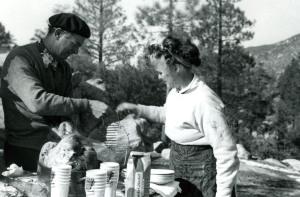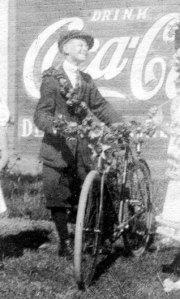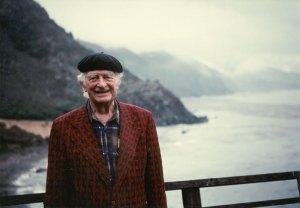
Linus and Ava Helen Pauling. Angeles National Forest, Thanksgiving Day, 1952.
This is the five-hundredth post that we’ve published on the Pauling Blog, and in this season of thanksgiving we find ourselves in a grateful mood. Five-hundred posts, surely at least a half-million words and, recently, our 500,000th view. Great thanks to you, our readers, who continue to seek out and use this resource in steadily increasing measure.
To celebrate this milestone, we are publishing a few excerpts from one of our favorite Pauling manuscripts. Titled “An Extraordinary Life: An Autobiographical Ramble,” the piece was written by Pauling for presentation to the Institute for the Humanities in Saledo, Texas, April 1989. The text finds Pauling in an unusually reflective mood, speaking with serenity, at age 88, of a life spent dipping in and out of scientific disciplines in a most remarkable way.

Young Pauling, ca. 1910s.
[...] I am moderately smart. I estimate that there are 20,000 people in the United States who are smarter than I am, perhaps 15,000 women and 5,000 men. I reached this conclusion because a month after my wife and I got married, we had carried out some intelligence tests, and I discovered she was smarter than I, but we were already married. It was too late for me to do anything about it. Of course, I recognize that there are many physicists who are smarter than I am – theoretical physicists, most of them. There are a lot of smart people who have gone into theoretical physics, so there is a lot of competition there. I console myself with the thought that they may be smarter than I am and deeper thinkers than I am, but I have broader interests than they have. I don’t suppose that there is anybody else in the world who has a good background, knowledge of physics, mathematics, theoretical physics, and who knows a great deal about chemistry – the amount that I know.
When I was eleven years old with no outside inspiration – just library books – I started collecting insects. Not only collecting insects but reading about insects. I was filling my mind with a lot of information about the lepidoptera and diptera and so on. My father, a druggist, died when I was nine. There was another druggist who was a friend of the family to whom I went if I needed some chemicals when I got interested in chemistry, but I wasn’t interested in chemistry yet. I was just interested in insects when I was eleven. I said, “A person who collects insects needs to have a killing bottle.” And I got a Mason jar from my mother. So all I needed now was ten grams of potassium cyanide and perhaps fifty grams of plaster of paris. So Mr. Ziegler, the druggist, gave me ten grams of potassium cyanide and fifty grams of plaster of paris, and I took them home, went out on the back porch, because I knew that potassium cyanide was dangerous, and I dumped the potassium cyanide into the bottle. I mixed the plaster of paris with some water and put it in the bottle on top of it and let it harden. I had my killing bottle. I collected a lot of insects.
Next year I got interested in minerals. I didn’t have very many minerals, at least that I could recognize, only agates. So about all I could do was go around Portland looking for piles of gravel where someone was putting in a house foundation or sidewalk. I’d go through the gravel looking for chunks of agate.
Just think of what the difference is now. A young fellow gets interested in chemistry and is given a chemical set. The chemical set doesn’t contain any potassium cyanide. It doesn’t even contain any copper sulphate or anything interesting because they are all poisonous substances. Most chemicals are poisonous substances. These young budding chemists don’t have any chance to do anything interesting when they are given a chemical set anymore. As I look back, I think it is pretty remarkable that Mr. Zieglar, this friend of the family, would have just turned over one third of an ounce of potassium cyanide to me at age eleven. [...]

Linus and Ava Helen, camping near Palm Springs, 1924.
[...] I was very fortunate when I came to the California Institute of Technology. There was a new experimental technique that had been discovered only eight years before. This was the determination of the structure of crystals by the x-ray diffraction method. Roscoe Dickinson, a few years older than I, had been using this technique for three or four years at the California Institute of Technology. He was the first man to get a Ph.D. from the California Institute of Technology. He taught me the technique. I was very much excited about it. It took only a couple of months for him to teach me how to determine the structure of a rather simple crystal by taking x-ray diffraction photographs of it and then analyzing those photographs. Perhaps the greatest thing that he taught me was how to assess the reliability of your own conclusions. He taught me to ask every time I reached some conclusion:
“Have I made some assumption in reaching this conclusion? And what is the assumption? And what are the chances that this assumption is wrong? How reliable is the conclusion?” I have remembered this ever since and have continued to feel grateful to him ever since. It is possible to delude yourself if you have an original idea into thinking that there are observations that support this idea. Or it is possible when you think that you have developed some idea on the basis of a rational argument that you have made an assumption somewhere that isn’t justified. So this was very important in my development.
I hear people often describing me as a biochemist or as an organic chemist or something else. In fact, I never did like organic chemistry. I liked biochemistry even less. I didn’t have any courses to speak of in organic chemistry and no course at all in biochemistry. No course in any aspect of biology, nothing in medicine. But I have made contributions in the nutritional field and the biochemical field. If I were to go through my some eight hundred scientific papers, and see what fields of science I have made contributions to, I could say I am a x-ray crystallographer. I am a mineralogist, because the American Mineralogist Society gave me their Roebling Medal which they give every year to an outstanding mineralogist. I am a physical chemist. That was what I called myself originally and what my Ph.D. diploma says. I am a chemical engineer too with a degree and five years of practical experience. I am an analytical chemist. When I was nineteen years old, I didn’t have enough money to go back to my junior year at Oregon Agricultural College. As a sophomore I had taken the course in Quantitative Chemical Analysis and they gave me a job full time to teach the sophomore Chemical Analysis. So I am an analytical chemist too. And I am an organic chemist. I laid the theoretical foundation for the tetrahedral carbon atom and developed resonance hybrid concept. I explained a lot of things in organic chemistry. I am a biochemist. I am a molecular biologist and sort of originated this field in a sense. I am a geneticist and have made contributions. I’m an evolutionary scientist. [...]

Pauling in 1989 – an extraordinary life. Photo by Paolo M. Sutter.
[...] In 1937, I was invited to give the prestigious George Fisher Baker Lectures at Cornell University. I went there for one semester. There had been famous chemists who had held this appointment. One requirement was that you write a book. My lectures were on the nature of the chemical bond, and the book came out in 1939, The Nature of the Chemical Bond. It was a bestseller, published by Cornell University Press. After a year the editor of Cornell University Press wrote to me and said, “Your edition of 10,000 copies is just about sold out. Would you prepare a second edition?” And I said, “Well, it hasn’t been a year yet. Nothing much has happened, but there have been some changes in this field. But why should I prepare a second edition of the book?” He said, “Well, you don’t get any royalties from the book. It was a condition of your appointment as George Fisher Baker Lecturer in Chemistry that you should write the book and present the manuscript. There has never been a George Fisher Baker book that has gone into a second edition, but if you write a second edition, Cornell University Press will give you royalties on it.”
Well, that was a really good incentive. I got busy and added ten pages perhaps and it came out as the second edition in 1940 and ever since then I have collected royalties. On thinking back on this man, editor of Cornell University Press, he is really a remarkable man in that he should think that it would be unjust to me not to get royalties on that book that had become a scientific bestseller. He was Amish from Pennsylvania and perhaps this may have something to do with his ethical standards. It is a good thing that people have ethical standards.
People keep saying to me, “How does it come about that you shifted your field every five or ten years in a remarkable way?” In fact, all that I did was to expand my field of interest. I started out first determining the structure of minerals, and the second job I did was to determine the structure of an intermetallic compound — the first intermetallic compound to have its structure determined. For about ten years I worked on the structure of silicate minerals and of various other inorganic compounds.
So that was one period, but then I got interested in the structure of organic molecules. And there was another technique. We built the first apparatus in the United States to determine the structure of gas molecules by electron diffraction. A friend of mine, Herman Mark in Germany, was the man who built the very first apparatus of this sort. So I began determining interatomic distances, and applying quantum mechanics which I had learned as one of the first people in the field in 1926 when I was in Germany on a Guggenheim Fellowship. All of this related to the question of the nature of the chemical bond. In the 1930s I formulated several new ideas about chemical bonds.
In 1935 the Rockefeller Foundation had been supporting my work on the crystal structure of the sulphide minerals, and they said to me, “You know, we’re not really interested in the sulphide minerals. We’re interested in biological substances.” They had been giving me five thousand dollars a year. I thought, “What do I know about biological materials? Not very much. Hemoglobin, red cells in the blood, molecular weight about 68,000, that has four iron atoms in it. Iron compounds often are paramagnetic. So why don’t I apply to the Rockefeller Foundation and suggest that I measure the magnetic susceptibility of hemoglobin and hemoglobin derivatives?” So I did. And they gave me fifty thousand dollars. This shows that these fellows in the big foundations can influence activities of scientists.
So we measured the magnetic susceptibility of blood. Venus blood turned out to be paramagnetic, and arterial blood was diamagnetic, meaning repelled by a magnet. Careful measurements of this sort gave astonishing information about the structure of the hemoglobin molecule. So then I thought, “Well, what about the rest of the hemoglobin molecule? There are four iron atoms and 9,996 other atoms. What are they doing? So I had better work on the structure of proteins.” I was giving a talk in 1936 at the Rockefeller Institute for Medical Research about the magnetic properties of hemoglobin. A man named Karl Landsteiner sent word to me, asking me to come to his laboratory to talk to him. I did. He said he was making immunological studies — antibodies, antitoxins. He wanted to know if I could explain some of his observations. So I thought about them for four years and finally wrote a paper, and when the second edition of his book came out there was a chapter by me on the molecular structure of antibodies. I hadn’t changed my course. I’d just gone on roads that have diverged a little from the ones I’d been going on.
